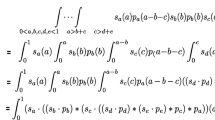Abstract
In recent years, many algorithmic strategies have been developed to exploit single-cell mutational profiles generated via sequencing experiments of cancer samples and return reliable models of cancer evolution. Here, we introduce the COB-tree algorithm, which summarizes the solutions explored by state-of-the-art methods for clonal tree inference, to return a unique consensus optimum branching tree. The method proves to be highly effective in detecting pairwise temporal relations between genomic events, as demonstrated by extensive tests on simulated datasets. We also provide a new method to visualize and quantitatively inspect the solution space of the inference methods, via Principal Coordinate Analysis. Finally, the application of our method to a single-cell dataset of patient-derived melanoma xenografts shows significant differences between the COB-tree solution and the maximum likelihood ones.
Access this chapter
Tax calculation will be finalised at checkout
Purchases are for personal use only
Similar content being viewed by others
References
Aguse, N., Qi, Y., El-Kebir, M.: Summarizing the solution space in tumor phylogeny inference by multiple consensus trees. Bioinformatics 35(14), i408–i416 (2019). https://doi.org/10.1093/bioinformatics/btz312
Altrock, P.M., Liu, L.L., Michor, F.: The mathematics of cancer: integrating quantitative models. Nat. Rev. Cancer 15(12), 730–745 (2015)
Angaroni, F., et al.: PMCE: efficient inference of expressive models of cancer evolution with high prognostic power. Bioinformatics 38, 754–762 (2021). https://doi.org/10.1093/bioinformatics/btab717
Bolger, A.M., Lohse, M., Usadel, B.: Trimmomatic: a flexible trimmer for Illumina sequence data. Bioinformatics 30(15), 2114–2120 (2014)
Bouckaert, R., et al.: BEAST 2: a software platform for Bayesian evolutionary analysis. PLOS Comput. Biol. 10(4), e1003537 (2014). https://doi.org/10.1371/journal.pcbi.1003537
Caravagna, G., et al.: Detecting repeated cancer evolution from multi-region tumor sequencing data. Nat. Methods 15(9), 707–714 (2018). https://doi.org/10.1038/s41592-018-0108-x
Christensen, S., et al.: Detecting evolutionary patterns of cancers using consensus trees. Bioinformatics 36(Suppl. 2), I684–I691 (2020). https://doi.org/10.1093/bioinformatics/btaa801. pmid: 33381820
Christensen, S., et al.: Detecting evolutionary patterns of cancers using consensus trees. Bioinformatics 36(Suppl. 2), i684–i691 (2020)
Chu, Y.-J.: On the shortest arborescence of a directed graph. Sci. Sinica 14, 1396–1400 (1965)
DePristo, M.A., et al.: A framework for variation discovery and genotyping using next-generation DNA sequencing data. Nat. Genet. 43(5), 491 (2011)
Dobin, A., et al.: STAR: ultrafast universal RNA-seq aligner. Bioinformatics 29(1), 15–21 (2013)
Edmonds, J.: Optimum branchings. J. Res. Natl. Bureau Stand. B 71, 233–240 (1967)
Govek, K., Sikes, C., Oesper, L.: A consensus approach to infer tumor evolutionary histories. In: Proceedings of the 2018 ACM International Conference on Bioinformatics, Computational Biology, and Health Informatics, BCB 2018, pp. 63–72. Association for Computing Machinery, New York (2018). https://doi.org/10.1145/3233547.3233584. ISBN 978-1-4503-5794-4
Gower, J.C.: Adding a point to vector diagrams in multivariate analysis. Biometrika 55(3), 582–585 (1968). https://doi.org/10.1093/biomet/55.3.582
Gower, J.C.: Some distance properties of latent root and vector methods used in multivariate analysis. Biometrika 53(3–4), 325–338 (1966). https://doi.org/10.1093/biomet/53.3-4.325
Jahn, K., Kuipers, J., Beerenwinkel, N.: Tree inference for single-cell data. Genome Biol. 17(1), 86 (2016). https://doi.org/10.1186/s13059-016-0936-x
Kuipers, J., Moffa, G.: Uniform random generation of large acyclic digraphs. Stat. Comput. 25(2), 227–242 (2013). https://doi.org/10.1007/s11222-013-9428-y
Langmead, B., Salzberg, S.L.: Fast gapped-read alignment with Bowtie 2. Nat. Methods 9(4), 357–359 (2012)
O’Reilly, J.E., Donoghue, P.C.J.: The efficacy of consensus tree methods for summarizing phylogenetic relationships from a posterior sample of trees estimated from morphological data. Syst. Biol. 67(2), 354–362 (2018). https://doi.org/10.1093/sysbio/syx086
Patruno, L., et al.: A review of computational strategies for denoising and imputation of single-cell transcriptomic data. Briefings Bioinform. 22(4), bbaa222 (2021). https://doi.org/10.1093/bib/bbaa222
Ramazzotti, D., et al.: CAPRI: efficient inference of cancer progression models from cross-sectional data. Bioinformatics 31(18), 3016–3026 (2015). https://doi.org/10.1093/bioinformatics/btv296
Ramazzotti, D., et al.: LACE: inference of cancer evolution models from longitudinal single-cell sequencing data. J. Comput. Sci. 58, 101523 (2022). https://doi.org/10.1016/j.jocs.2021.101523. https://www.sciencedirect.com/science/article/pii/S1877750321001848
Ramazzotti, D., et al.: Learning mutational graphs of individual tumour evolution from single-cell and multi-region sequencing data. BMC Bioinform. 20(1), 210 (2019). https://doi.org/10.1186/s12859-019-2795-4
Ramazzotti, D., et al.: Variant calling from scRNA-seq data allows the assessment of cellular identity in patient-derived cell lines. Nat. Commun. 13(1), 1–3 (2022)
Ramazzotti, D., et al.: VERSO: a comprehensive framework for the inference of robust phylogenies and the quantification of intra-host genomic diversity of viral samples. Patterns 2(3), 100212 (2021). https://doi.org/10.1016/j.patter.2021.100212
Rambow, F., et al.: Toward minimal residual disease-directed therapy in Melanoma. Cell 174(4), 843–855.e19 (2018). https://doi.org/10.1016/j.cell.2018.06.025
Schwartz, R., Schäffer, A.A.: The evolution of tumour phylogenetics: principles and practice. Nat. Rev. Genet. 18(4), 213–229 (2017). https://doi.org/10.1038/nrg.2016.170
Singer, J., et al.: Bioinformatics for precision oncology. Briefings Bioinform. 20(3), 778–788 (2019)
Tarjan, R.E.: Finding optimum branchings. Networks 7(1), 25–35 (1977). https://doi.org/10.1002/net.3230070103
Acknowledgments
This work was supported by a Bicocca 2020 Starting Grant and Google Cloud Academic Research Grant to DR and FA. Partial support is also granted by the CRUK/AIRC Accelerator Award #22790 “Single-cell Cancer Evolution in the Clinic”. The funders had no role in the design and conduct of the study, analysis, and interpretation of the data, preparation of the manuscript, and decision to submit the manuscript for publication.
Author information
Authors and Affiliations
Corresponding author
Editor information
Editors and Affiliations
Rights and permissions
Copyright information
© 2023 The Author(s), under exclusive license to Springer Nature Switzerland AG
About this paper
Cite this paper
Maspero, D., Angaroni, F., Patruno, L., Ramazzotti, D., Posada, D., Graudenzi, A. (2023). Exploring the Solution Space of Cancer Evolution Inference Frameworks for Single-Cell Sequencing Data. In: De Stefano, C., Fontanella, F., Vanneschi, L. (eds) Artificial Life and Evolutionary Computation. WIVACE 2022. Communications in Computer and Information Science, vol 1780. Springer, Cham. https://doi.org/10.1007/978-3-031-31183-3_6
Download citation
DOI: https://doi.org/10.1007/978-3-031-31183-3_6
Published:
Publisher Name: Springer, Cham
Print ISBN: 978-3-031-31182-6
Online ISBN: 978-3-031-31183-3
eBook Packages: Computer ScienceComputer Science (R0)




